oil temperature Alfa Romeo 166 2006 Owner handbook (in English)
[x] Cancel search | Manufacturer: ALFA ROMEO, Model Year: 2006, Model line: 166, Model: Alfa Romeo 166 2006Pages: 272, PDF Size: 4.17 MB
Page 78 of 272
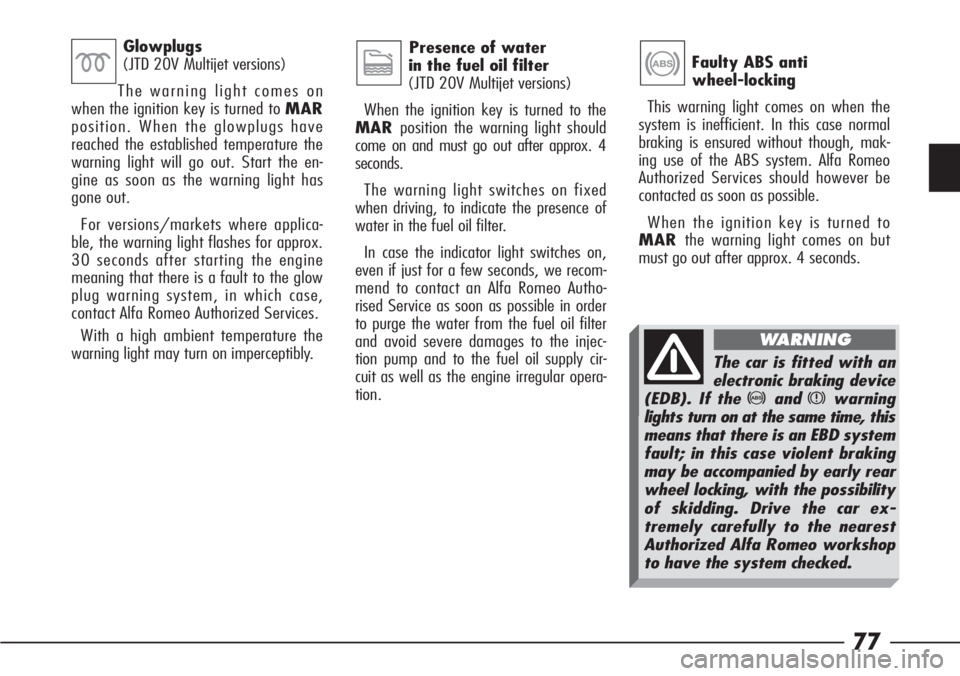
77
Faulty ABS anti
wheel-locking
This warning light comes on when the
system is inefficient. In this case normal
braking is ensured without though, mak-
ing use of the ABS system. Alfa Romeo
Authorized Services should however be
contacted as soon as possible.
When the ignition key is turned to
MARthe warning light comes on but
must go out after approx. 4 seconds.>
Presence of water
in the fuel oil filter
(JTD 20V Multijet versions)
When the ignition key is turned to the
MARposition the warning light should
come on and must go out after approx. 4
seconds.
The warning light switches on fixed
when driving, to indicate the presence of
water in the fuel oil filter.
In case the indicator light switches on,
even if just for a few seconds, we recom-
mend to contact an Alfa Romeo Autho-
rised Service as soon as possible in order
to purge the water from the fuel oil filter
and avoid severe damages to the injec-
tion pump and to the fuel oil supply cir-
cuit as well as the engine irregular opera-
tion.
c
Glowplugs
(JTD 20V Multijet versions)
The warning light comes on
when the ignition key is turned to MAR
position. When the glowplugs have
reached the established temperature the
warning light will go out. Start the en-
gine as soon as the warning light has
gone out.
For versions/markets where applica-
ble, the warning light flashes for approx.
30 seconds after starting the engine
meaning that there is a fault to the glow
plug warning system, in which case,
contact Alfa Romeo Authorized Services.
With a high ambient temperature the
warning light may turn on imperceptibly.
m
The car is fitted with an
electronic braking device
(EDB). If the
>andxwarning
lights turn on at the same time, this
means that there is an EBD system
fault; in this case violent braking
may be accompanied by early rear
wheel locking, with the possibility
of skidding. Drive the car ex-
tremely carefully to the nearest
Authorized Alfa Romeo workshop
to have the system checked.
WARNING
Page 92 of 272
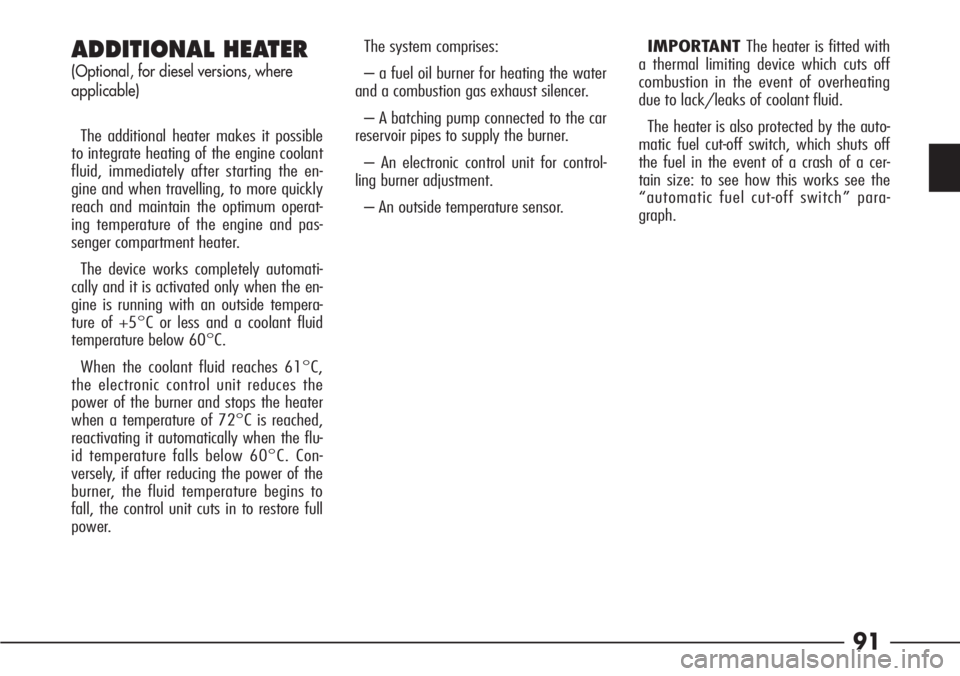
91
ADDITIONAL HEATER
(Optional, for diesel versions, where
applicable)
The additional heater makes it possible
to integrate heating of the engine coolant
fluid, immediately after starting the en-
gine and when travelling, to more quickly
reach and maintain the optimum operat-
ing temperature of the engine and pas-
senger compartment heater.
The device works completely automati-
cally and it is activated only when the en-
gine is running with an outside tempera-
ture of +5°C or less and a coolant fluid
temperature below 60°C.
When the coolant fluid reaches 61°C,
the electronic control unit reduces the
power of the burner and stops the heater
when a temperature of 72°C is reached,
reactivating it automatically when the flu-
id temperature falls below 60°C. Con-
versely, if after reducing the power of the
burner, the fluid temperature begins to
fall, the control unit cuts in to restore full
power.The system comprises:
– a fuel oil burner for heating the water
and a combustion gas exhaust silencer.
– A batching pump connected to the car
reservoir pipes to supply the burner.
– An electronic control unit for control-
ling burner adjustment.
– An outside temperature sensor.IMPORTANT The heater is fitted with
a thermal limiting device which cuts off
combustion in the event of overheating
due to lack/leaks of coolant fluid.
The heater is also protected by the auto-
matic fuel cut-off switch, which shuts off
the fuel in the event of a crash of a cer-
tain size: to see how this works see the
“automatic fuel cut-off switch” para-
graph.
Page 140 of 272
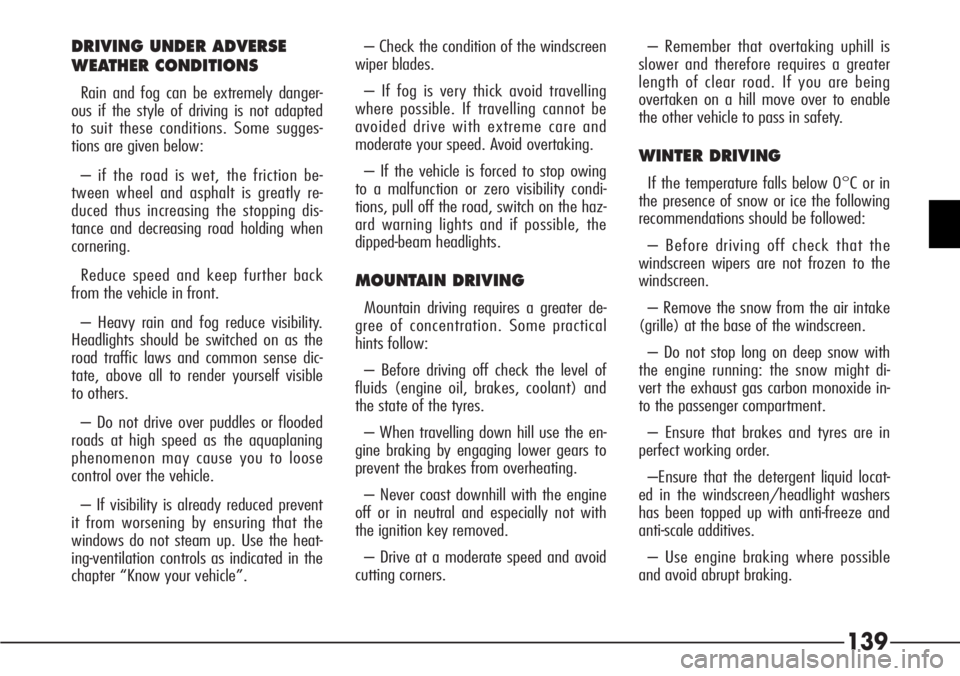
139
DRIVING UNDER ADVERSE
WEATHER CONDITIONS
Rain and fog can be extremely danger-
ous if the style of driving is not adapted
to suit these conditions. Some sugges-
tions are given below:
– if the road is wet, the friction be-
tween wheel and asphalt is greatly re-
duced thus increasing the stopping dis-
tance and decreasing road holding when
cornering.
Reduce speed and keep further back
from the vehicle in front.
– Heavy rain and fog reduce visibility.
Headlights should be switched on as the
road traffic laws and common sense dic-
tate, above all to render yourself visible
to others.
– Do not drive over puddles or flooded
roads at high speed as the aquaplaning
phenomenon may cause you to loose
control over the vehicle.
– If visibility is already reduced prevent
it from worsening by ensuring that the
windows do not steam up. Use the heat-
ing-ventilation controls as indicated in the
chapter “Know your vehicle”.– Check the condition of the windscreen
wiper blades.
– If fog is very thick avoid travelling
where possible. If travelling cannot be
avoided drive with extreme care and
moderate your speed. Avoid overtaking.
– If the vehicle is forced to stop owing
to a malfunction or zero visibility condi-
tions, pull off the road, switch on the haz-
ard warning lights and if possible, the
dipped-beam headlights.
MOUNTAIN DRIVING
Mountain driving requires a greater de-
gree of concentration. Some practical
hints follow:
– Before driving off check the level of
fluids (engine oil, brakes, coolant) and
the state of the tyres.
– When travelling down hill use the en-
gine braking by engaging lower gears to
prevent the brakes from overheating.
– Never coast downhill with the engine
off or in neutral and especially not with
the ignition key removed.
– Drive at a moderate speed and avoid
cutting corners.– Remember that overtaking uphill is
slower and therefore requires a greater
length of clear road. If you are being
overtaken on a hill move over to enable
the other vehicle to pass in safety.
WINTER DRIVING
If the temperature falls below 0°C or in
the presence of snow or ice the following
recommendations should be followed:
– Before driving off check that the
windscreen wipers are not frozen to the
windscreen.
– Remove the snow from the air intake
(grille) at the base of the windscreen.
– Do not stop long on deep snow with
the engine running: the snow might di-
vert the exhaust gas carbon monoxide in-
to the passenger compartment.
– Ensure that brakes and tyres are in
perfect working order.
–Ensure that the detergent liquid locat-
ed in the windscreen/headlight washers
has been topped up with anti-freeze and
anti-scale additives.
– Use engine braking where possible
and avoid abrupt braking.
Page 208 of 272
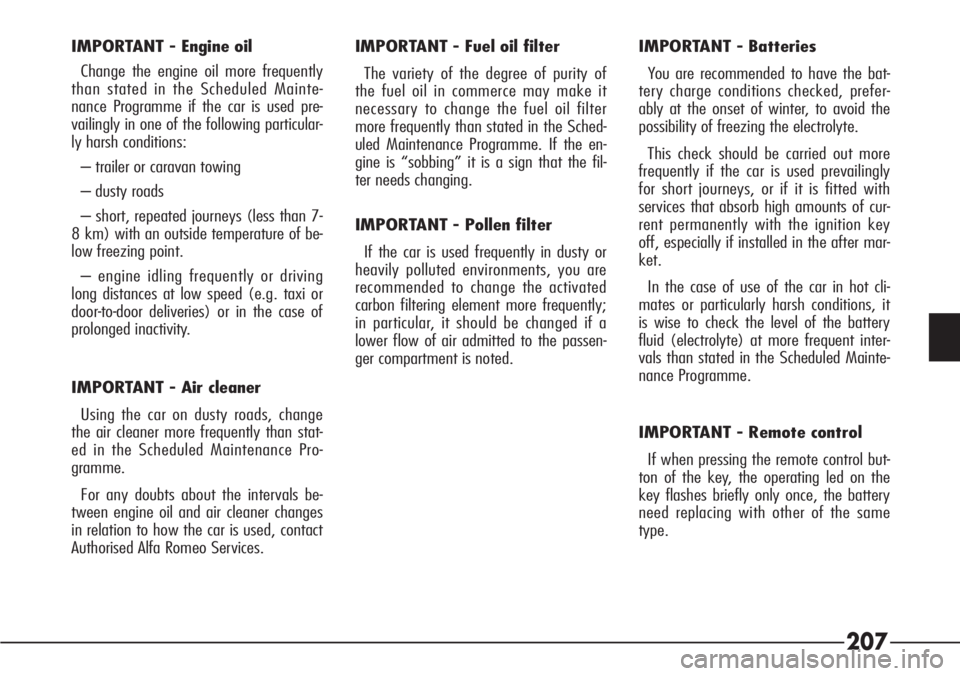
207
IMPORTANT - Engine oil
Change the engine oil more frequently
than stated in the Scheduled Mainte-
nance Programme if the car is used pre-
vailingly in one of the following particular-
ly harsh conditions:
– trailer or caravan towing
– dusty roads
– short, repeated journeys (less than 7-
8 km) with an outside temperature of be-
low freezing point.
– engine idling frequently or driving
long distances at low speed (e.g. taxi or
door-to-door deliveries) or in the case of
prolonged inactivity.
IMPORTANT - Air cleaner
Using the car on dusty roads, change
the air cleaner more frequently than stat-
ed in the Scheduled Maintenance Pro-
gramme.
For any doubts about the intervals be-
tween engine oil and air cleaner changes
in relation to how the car is used, contact
Authorised Alfa Romeo Services.IMPORTANT - Fuel oil filter
The variety of the degree of purity of
the fuel oil in commerce may make it
necessary to change the fuel oil filter
more frequently than stated in the Sched-
uled Maintenance Programme. If the en-
gine is “sobbing” it is a sign that the fil-
ter needs changing.
IMPORTANT - Pollen filter
If the car is used frequently in dusty or
heavily polluted environments, you are
recommended to change the activated
carbon filtering element more frequently;
in particular, it should be changed if a
lower flow of air admitted to the passen-
ger compartment is noted.IMPORTANT - Batteries
You are recommended to have the bat-
tery charge conditions checked, prefer-
ably at the onset of winter, to avoid the
possibility of freezing the electrolyte.
This check should be carried out more
frequently if the car is used prevailingly
for short journeys, or if it is fitted with
services that absorb high amounts of cur-
rent permanently with the ignition key
off, especially if installed in the after mar-
ket.
In the case of use of the car in hot cli-
mates or particularly harsh conditions, it
is wise to check the level of the battery
fluid (electrolyte) at more frequent inter-
vals than stated in the Scheduled Mainte-
nance Programme.
IMPORTANT - Remote control
If when pressing the remote control but-
ton of the key, the operating led on the
key flashes briefly only once, the battery
need replacing with other of the same
type.
Page 230 of 272

229
PLASTIC PARTS
Should it be necessary to remove dust,
dirt, etc. from the surface of the light u-
nits (and/or direction indicators) only use
a solution of neutral soap and water and
a soft cloth.
Absolutely never use chemical solvents
and/or petroleum derivatives such as
petrol, methylated spirits, ammonia, ace-
tone, etc. which could spoil the material
and reduce its transparency, adversely af-
fecting travelling safety.
For internal plastic parts use specific
products to preserve the appearance of
the components.
I.C.S. MASK AND CENTRAL
CONSOLE
Remove finger prints with common alco-
hol-free water and surfactants glass deter-
gent. Rub surfaces with a clean cotton
rag moistened with detergent.
Never use spirit or
petrol to clean the glass
on the instrument panel.
Do not keep aerosol cans
in the car. There is the
risk they might explode. Aerosol
cans must never be exposed to a
temperature above 50°C. The tem-
perature inside the car might go
well beyond that figure when ex-
posed to the sun’s rays.
WARNINGSTEERING WHEEL/GEAR LEVER
KNOB WITH GENUINE
LEATHER COVERING
These components shall only be cleaned
with water and neutral soap. Never use
spirit or alcohol-based products.
Before using special products for clean-
ing interiors, read carefully label instruc-
tions and indications to make sure they
are free from spirit and/or alcohol-based
substances.
If when cleaning the windscreen with
special glass products, some drops fall on
the leather covering of the steering
wheel/gear lever knob remove them im-
mediately and then clean with water and
neutral soap.
IMPORTANTTake the utmost care
when engaging the steering lock to pre-
vent scratching the leather covering.
Page 244 of 272
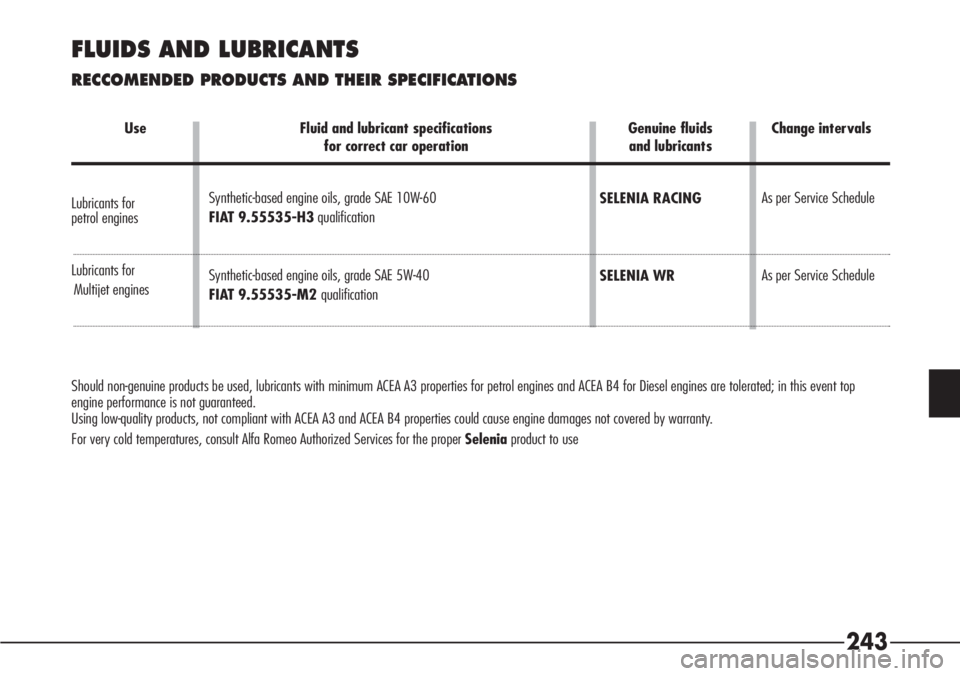
243
FLUIDS AND LUBRICANTS
RECCOMENDED PRODUCTS AND THEIR SPECIFICATIONS
Synthetic-based engine oils, grade SAE 10W-60
FIAT 9.55535-H3qualification
Synthetic-based engine oils, grade SAE 5W-40
FIAT 9.55535-M2 qualification
Should non-genuine products be used, lubricants with minimum ACEA A3 properties for petrol engines and ACEA B4 for Diesel engines are tolerated; in this event top
engine performance is not guaranteed.
Using low-quality products, not compliant with ACEA A3 and ACEA B4 properties could cause engine damages not covered by warranty.
For very cold temperatures, consult Alfa Romeo Authorized Services for the proper Seleniaproduct to useSELENIA RACING
SELENIA WRAs per Service Schedule
As per Service Schedule Use Fluid and lubricant specifications Genuine fluids Change intervals
for correct car operation and lubricants
Lubricants for
petrol engines
Lubricants for
Multijet engines
Page 264 of 272
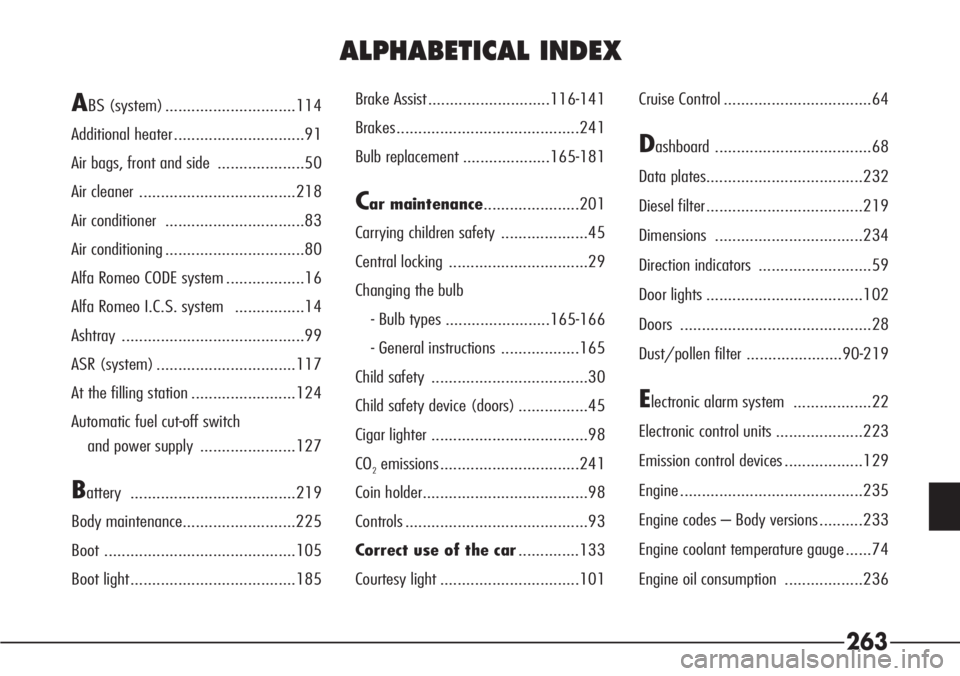
263
ABS (system) ..............................114
Additional heater ..............................91
Air bags, front and side ....................50
Air cleaner ....................................218
Air conditioner ................................83
Air conditioning ................................80
Alfa Romeo CODE system ..................16
Alfa Romeo I.C.S. system ................14
Ashtray ..........................................99
ASR (system) ................................117
At the filling station ........................124
Automatic fuel cut-off switch
and power supply ......................127
Battery ......................................219
Body maintenance..........................225
Boot ............................................105
Boot light......................................185Brake Assist ............................116-141
Brakes..........................................241
Bulb replacement ....................165-181
Car maintenance......................201
Carrying children safety ....................45
Central locking ................................29
Changing the bulb
- Bulb types ........................165-166
- General instructions ..................165
Child safety ....................................30
Child safety device (doors) ................45
Cigar lighter ....................................98
CO
2emissions ................................241
Coin holder......................................98
Controls ..........................................93
Correct use of the car..............133
Courtesy light ................................101Cruise Control ..................................64
Dashboard ....................................68
Data plates....................................232
Diesel filter....................................219
Dimensions ..................................234
Direction indicators ..........................59
Door lights ....................................102
Doors ............................................28
Dust/pollen filter ......................90-219
Electronic alarm system ..................22
Electronic control units ....................223
Emission control devices ..................129
Engine ..........................................235
Engine codes – Body versions ..........233
Engine coolant temperature gauge ......74
Engine oil consumption ..................236
ALPHABETICAL INDEX